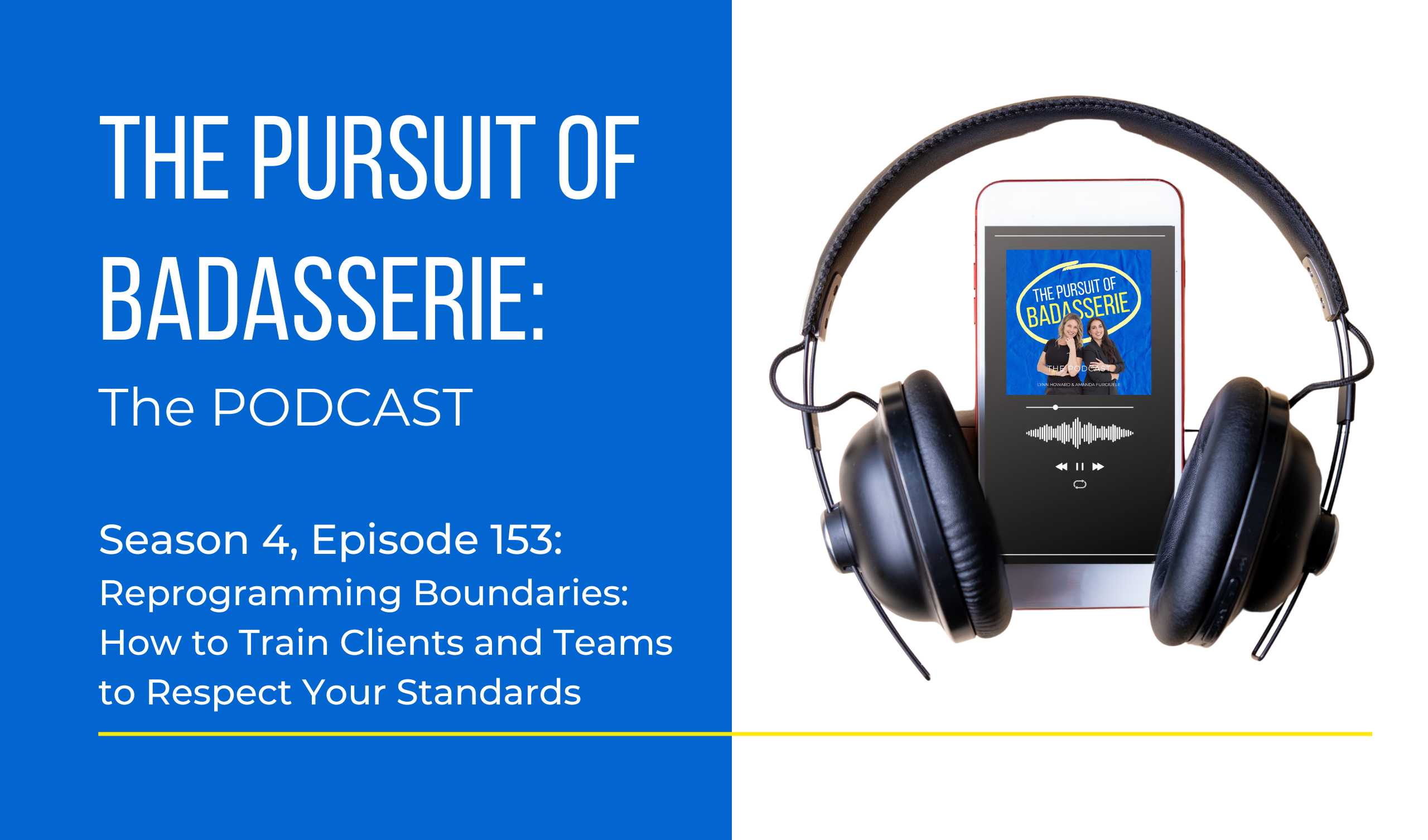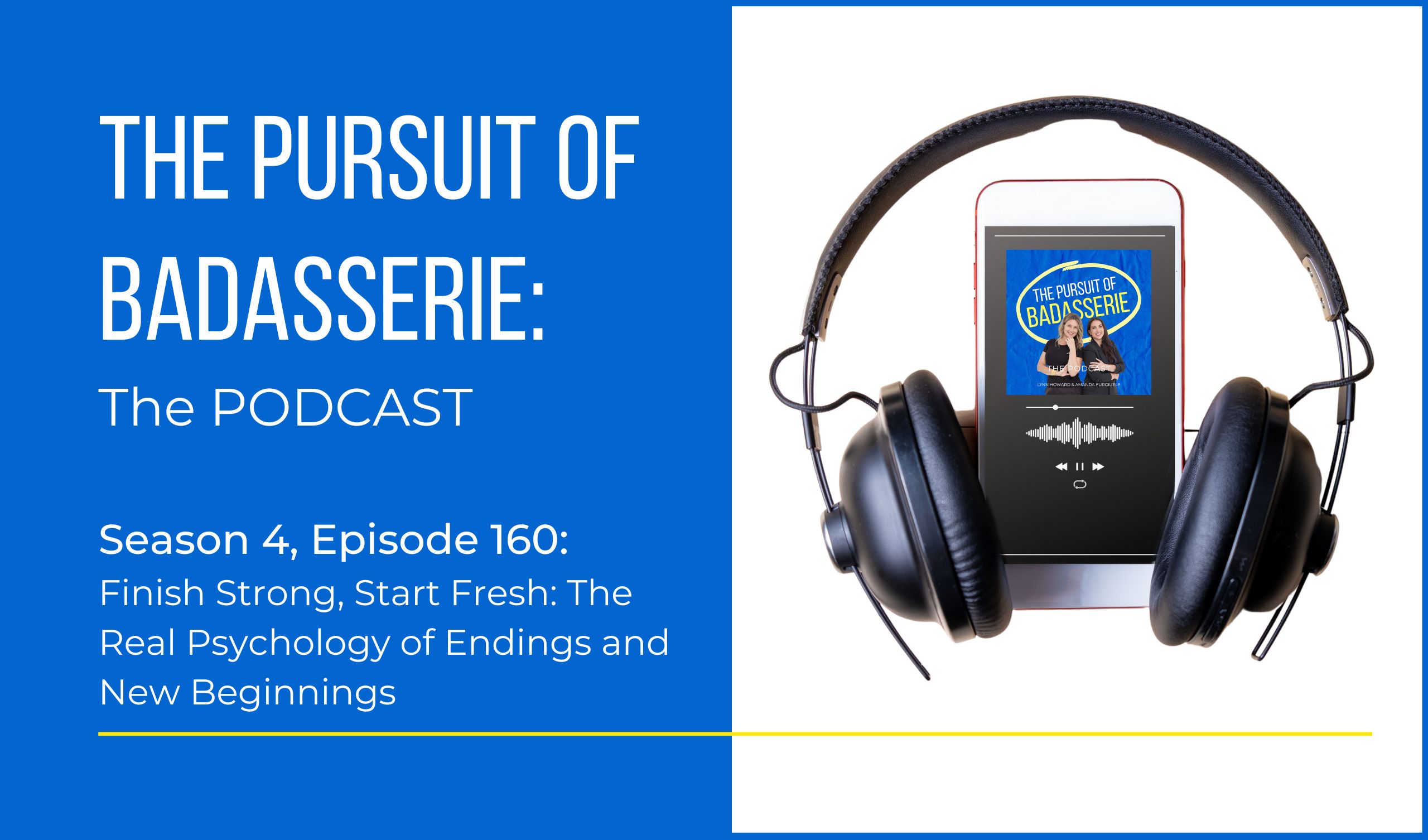Episode 153: Reprogramming Boundaries: How to Train Clients and Teams to Respect Your Standards
Boundaries are not optional—they are the foundation of sustainable success. In this episode of The Pursuit of Badasserie: The Podcast, we dive deep into what it really means to lead with integrity and enforce standards in your business.
From clients who test the limits to top-performing team members who think the rules don’t apply to them, entrepreneurs often face the challenge of holding the line without losing momentum. The truth? You are always training people how to treat you—whether you realize it or not.

This episode covers:
- Why integrity isn’t situational—and how it shapes your business legacy
- How to retrain clients and team members who have slipped outside your boundaries
- The danger of “golden handcuffs” and why leaders must enforce standards even with top performers
- The HR systems every business owner should implement—even solopreneurs
- How to balance accountability with grace while still getting buy-in from your team
Entrepreneurship doesn’t get easier—you simply get better at managing the challenges. If you’ve been struggling with clients who overstep or team members who resist expectations, this conversation gives you the tools to reset, reprogram, and lead with authority.
Make sure to subscribe to our YouTube or Spotify and leave us a review!
- Like the show? LEAVE US A REVIEW wherever you listen!
- Have a question? CONTACT US at info@thepursuitofbadasserie.com!
- Want to sponsor us? Find out how HERE.
…
Read the full transcript of this episode below:
Lynn Howard
Hey, I’m Lynn.
Amanda Furgiuele
And I’m Amanda. Welcome to The Pursuit of Badasserie, the podcast. Today, we’re going to retouch on a different way, something that we talk about a lot, which is training people how to treat us and setting up boundaries within your own business.
This has come up a lot, a lot, and in different ways over the course of the last couple of weeks and months with our clients, with our clients’ clients.
So we wanted to talk about what this looks like and how it can affect and how you can change it in your business.
Lynn Howard
here. Yeah. Yeah. I think this time we’re going to focus more on, like, the team and the client aspect, like, because maybe before we’ve done a bit more broad, but so many conversations.
I’ll start with the client side, that, you know, how a client is wanting you to answer the phone after hours or wanting to meet with you at all times or expecting you to bend over backwards for X, Y, Z.
And there is an aspect of we train others how to treat us, but there, even if we have trained them, are we holding them accountable?
Are we, like, following through? And there’s this dance that you play to, at the end of the day, if your clients are being jerks and and expecting, expecting, expecting, like, how have you set them up in order to be able to push that onto you?
Amanda Furgiuele
Absolutely. And I’m thinking of one particular client that I have recently, who was just trying to be nice. And that was the reason that she’s like, it all blew up because she was trying to be nice.
Like, oh, well, she seemed like a nice person. So I just wanted to throw this thing an extra to be nice, not clarifying that it was an extra.
so then the client was upset when she didn’t do that the second time and the second and the third time.
And then it became this spiraling out of control. Well, and now I’m not getting what I paid for because she thought, because you were being nice and seriously over-delivering that suddenly that was going to be the case forever.
And you, the reason she was over-delivering was because she was kind of slow on clients at the time. She’s like, well, I had the time to do more.
I’m like, okay, but now you’ve set your client up to think that you’re going to be doing, you know, as a social media manager, you’re going to do two posts a day, every day.
And they think that’s part of the package, but they’re only paying for four a week. And so you did that because you were being nice and because you’d had a lower client load, but now you’d have a better client load.
Thank Now you don’t have the time, so you’re doing what’s on the contract, but the client doesn’t know that, and so then it just, they went off the rails, and now they think that there’s this huge problem, and that they’re not getting what they paid for when really they were getting quadruple what they were paying for in the beginning, and so a lot of times it comes from the best intentions, like you don’t even realize it’s happening, you’re just trying to be nice, like it’s, and then suddenly it’s an issue, like, and oh, look, she had, she’s a, she was a friend of a friend, so she had no My phone number, my personal phone number, and so she would start calling and asking for progress, and it wasn’t that big of deal, and then it became a big deal, and so setting those, those boundaries, and then it became much harder to pull away, and to pull back in a way that was still professional and amicable, once they hit that point where had hit the fan.
Lynn Howard
Yeah, listen, I’ve been in that position many times, I’ve gotten burnt, because I would give and give and give as a consultant, as reason points, just Okay,
When I own my security company, and definitely got bit a few times. And I think, yeah, we were training them to think that that is that’s the norm.
And so I have to watch myself because I just recently brought because you know, I don’t take on too many clients, but I brought on somebody who’s a friend.
And I had this conversation with them, but even having the conversation with them, but because there’s a hard line on essentially where we need to get kind of everything in order before this happens.
I’ve been doing a lot more time, but I had to like, re like pull myself back and say, Hey, like, you know, this is our norm.
This is how much you get per the contract, but I’m front loading a lot of things because of X, Y, Z.
And I, I have to make that known because I’ve been bit so many times and it is a giver mentality in some aspects, but also it’s like, not, but it could be.
It could come from several different ways and so like not having boundaries, it might be in your contract that your client gets X amount of access to you but the second you start answering calls or doing things outside of that contractual agreement, they feel like that is the norm and not the contract.
I have a client who’s lost hundreds of thousands of dollars because they, and it wasn’t just necessarily them, it was their team members that kind of allowed some of the boundaries to be broken or stretched we’ll say.
And the client demanded all this money back because of X and Y and because of Z. And so, listen, we have to first make the boundaries clear.
And then we have to, and this is. And I think for podcast, we’re going after the fact, right? So they’re already breaking it.
So how can you kind of revamp, reposition yourself? First is to remind them of the agreement. And that could be in a simple email and a text.
Then it could be in a subtle way of, like, having your business hours at the bottom of your signature, only answering questions or messages during those certain times, having it on your voicemail of, if this is urgent and this is what an emergency is, sending out an email or a text to say, this is what constitutes as an emergency, this is what’s not a non-emergency, to, like, spell it out.
And not in a pointing the finger aggressive way, but you can be as subtle or as aggressive, but shame on
If you’ve allowed them to break it. So first it’s on you to reprogram them. And then it’s like not, and I always, when I have clients, it’s easier when I direct clients to do it versus myself, but I always err on the side of really, really, really, really, really strictness, like to the point of like, there’s no wiggle room when you’re reprogramming people into the boundaries.
But then you have to be careful to not get back into the same position that you are once you start kind of loosening the reins a little bit.
But yeah, and that constant communication of not allowing them to break. And sometimes you have to have meetings. Sometimes you need to put new things into place because it’s a need.
Now they’re used to that. And sometimes you’re going to lose people because you set up the expectations of, even if the contract said different, you set up new expectations that it was going to be like this.
And now it’s not. And so they’re not. We’re going to be able to come back from that, which means bad reviews and different things like that as well.
Amanda Furgiuele
And I think it’s really important that you also develop some scripts around it, too. Like, what are you going to say and have it already practiced, have it already run down your brain?
Because I think a lot of times when we fall back on our old patterns or when we try to be nice is when we don’t know what to say when there’s a bit of confrontation there.
And I’ll give a pretty easy example of retail sales. Somebody asks for an exception on a policy. Oh, this return policy or oh, I was sick or oh, I was this or, you know, it’s the day after my birthday, but this, this and this.
Like there’s always going to be a reason why a client wants to break a policy. And as a business owner, you can absolutely choose to break the policy and do whatever you want to do.
But you’re setting up that example for your entire team. So like if you as the owner decide or as the manager decide to break a policy, then it’s.
That’s a precedent. It’s like a legal precedent where someone’s like, oh, well, so-and-so last week, you gave them a discount on this.
Or like, oh, well, you gave this person an extension. You did this for this person. You think it’s never going to come back around, but it often will.
So getting yourself used to saying the policy. What is the policy? Know the policy. If you don’t know the policy, that’s part of the problem right there.
But know the policy and know what you’re going to say and have those confrontational mirror speeches with yourself if you need to.
I like to have it as almost an SOP for your team members as well. This is what we say.
If somebody calls and they want a refund, if somebody calls and they’re complaining about damage to a shipment, this is what we say.
This is our policy around this. And make sure it’s drilled home because a lot of times some of that disconnect happens just because you’re not 100% sure what to say.
You don’t know what the rules are. You don’t know where the wiggle room is. You don’t know what your responsibilities are either to the client or to the company.
And so it trickles down in weird ways. And so I think that’s one of the easiest things you can do right away to help yourself get over these, you know, in this boundary setting way is to make an SOP around it, make some think about some scripts and practice them, practice what you’re going to say, because that will make it so much easier.
And even from a boundary setting of, you know, practice what you’re going to say about your business hours, practice what you’re going to say, because when you’re in the heat of the moment, you have that emotion.
It can cloud your judgment, cloud what you say. So if you’re, you know what your script is, it’ll come up much easier, and it will eventually help you set that boundary easier and clearer.
Lynn Howard
Yeah, not like cloud, but also like, if they can sometimes smell fear of the wobble, then they’re not going to take you as serious.
When you were talking, I was actually thinking of also external things that you can do, kind of like why I said it, like put it out in your email, put it out in your voice.
So it’s not actually. I know we always go back to fitness, but how some of my classes, like the Pilates or the yoga classes, because they actually shut the door versus grid, they’ll actually shut the door.
There’s a sign on it, do not interrupt. And there’s usually people waiting outside to fill seats. So at a certain time, if the seats aren’t full, they put people in.
So if somebody comes in and tries to look in their seat, because it’s numbered, their seats already full. So that’s another way of training them of like, hey, we’re not, we’re, we’re not going to like allow you to be late, show up when you need to show up type of thing.
So what are even some nonverbal cues you can do to help enhance the retraining and reprogramming of that for you and for them.
And so thinking of it like from a holistic lens. So let’s talk about that. So your VAs, your employees, your contractors, and how maybe they’re not living up to the standards.
They’re not doing the things that you need. Recently, I’ve had this conversation with a team and the people aren’t showing up to the team meetings.
Now, they’re top producers, but they’re not showing up to the team meetings because it was never a thing that was expected of them.
It wasn’t, you know, it was kind of loosey-goosey. And it’s interesting because with this particular dynamic, it’s the top producers aren’t.
So how can you reframe that? How can you, like, why is it important to be in the team? Why is it important for them to show up to these meetings?
And so it’s like reprogramming everybody to say, hey, we’re a collective. This This is how. This is our core values.
This is our vision. This is our mission. And this is what we’re doing. And so it’s like having to re-get their buy-in.
It’s having to remind them of like, hey, you are a top producer. So you have great influence on the others.
Like just you being in the meetings and not from an ego standpoint of you could add value to everybody.
We want to be more collaborative. We want to do this. We want to do that. And so it’s an interesting dynamic, but how to re-engage them, it is trying to, it’s having a conversation with them first and realigning them with the culture and the values and the direction in which your business is going.
I know you’ve dealt with this a lot with contractors as well.
Amanda Furgiuele
Absolutely. And I know there’s a lot of, when it comes to contractors specifically, it’s a lot of like, oh, what am I legally allowed to have them do?
To hack. And I enforce this rule or this cultural part of my company on a contractor who may not, you know, be legally required to be there.
And there are still ways you can subtly make it seem, I mean, you can subtly or not so subtly tell people this is an expectation, that if you want to be a contractor, then this is the expectation that we have in the company, that this is what you need to have.
Otherwise, we’re going to go with a different contractor. So there is some, there’s more wiggle room than you think when it comes to an employee versus a contractor versus, you know, all sorts of different types of under the table, there’s different types of employment that you might have, and there are different rules and regulations, depending on what state you’re in, country you’re in.
So there are some rules that have to be followed, and that doesn’t mean you can’t still have an expectation of what everybody who’s involved in your company should and should not be doing.
That’s just across the board, you can always choose to hire somebody else, can always choose to get a different contract or a different company to.
So understanding it goes back to, to some extent, our podcast on integrity. What’s your company stand for? What is it you’re trying to have as your policy, as your integrity, as your vision, as your mission?
And everybody you hire can be part of that. Does this person fit into that dynamic? And then when you are setting up expectations and boundaries and telling people what to do and what not to do, that can come into play there.
And I think, I know that it can feel harder with an independent contractor or with, you know, remote employees or anybody who’s maybe not there 24 seven, or even with that one, that one employee that we all have or have had, it’s just a little bit harder to deal with.
But, but, you know, in the end, it really is your responsibility as the owner, as the leader to set those boundaries and to hold the line.
You’ve got.
Lynn Howard
And I think with team members, regardless, independent contractors, a partner, employees, VAs, like nipping it quick and fast, because a lot of times we get the golden handcuff syndrome, right, and where we feel like, oh, we can’t correct them because they are our star person for XYZ.
I’m thinking of some personal that has just been happening. And at the end of the day, no, we all are on the same playing field, more or less.
And so we train others how to treat us, we train others how to show up in our business, especially when it’s our business, and even when it’s not our business.
And how we hold those accountable is super important. So how to reprogram or redirect them is almost the same way that you do with clients is first you have to acknowledge, then you have to, but with the team, it’s more so.
for a lot. Thanks So a buy-in because they’re a part of the team versus a client isn’t necessarily a buy-in.
It kind of is, but in a different way. So it is, and that buy-in can look very different, but it’s getting them to buy back into the values.
So the reason why that they’re there, the culture, the direction in which the business is going. And then the coming up with terms of like, hey, this is like the expectations.
And sometimes that can be common. Collaborative with the team members and sometimes not, but this is how we’re going to move forward.
But then the boundary and the expectations, once those are set, there’s no leeway, especially if they are a problem child, like let them work themselves out or let them build themselves up.
But sometimes a conversation has to be had if they’re more of a problem child, or if they’re having a hard time of like, what’s the one, two, three to get there.
And having, there is a little bit. The grace that you have to have with that expectations sometimes, and sometimes it’s not like bad behavior is bad behavior, and that shouldn’t be tolerated.
And it’s nicked. And if you, I kind of go back to like the parents who threaten and threaten and threaten, but don’t do anything.
And listen, I was there, I did that sometimes OT would get on me about that. And like, I remember like breaking that habit of like, you know, if you don’t do this, I’m going to do XYZ, knowing damn well that it’s It doesn’t happen, right?
So don’t be that type of leader, either. Like, if you’re going to say it, be about it, like do the thing.
And that is really important. And then having obviously the HR side of like, are they written up? Are they this?
Are they that? Like that structure really can help you stay in integrity with retraining and keeping the I’m accountable to that, that standard, that level.
Amanda Furgiuele
Yes, I think that is something a lot of people miss, particularly if you have no HR part of your company.
Like if you have a company that’s big enough that you have a separate HR department, then great. But a lot of business owners, and I would say for sure, obviously, solopreneurs, you are the HR.
I mean, or even if you have, you know, you’re the owner, but you have just a few independent contractors under you versus having employees or departments, you are the HR.
So you’ve got to be, you’ve got to have a system in place because the last thing you really want is that feeling of like, oh, they were blindsided by being fired or, or I don’t know how to, at what point do I fire them?
Well, that should be pretty easy to understand if you have a system in place like this, you know, three strikes, you’re out, or this infraction, this infraction, this, like, there should be almost a math.
you’ve got That’s equation of whether or not you’re firing somebody or they’re about to get fired. It shouldn’t be a surprise.
Like, oh, should I fire them or not? Like, well, okay, well, have they done what they said? Have they met these checks?
When you did your evaluation, did they fall in line with the expectations that you had set for them? And then you come to realize that nobody has any expectations.
Everybody’s just kind of like winging it. And that’s where it really gets into trouble is that you don’t have foundational system in place.
to make those decisions for you, to make it easier for you to run your business. So I think the HR side is what a lot of businesses forget about because, well, it kind of sucks to have to do it.
It sucks. Like nobody wants to do all the things, but it will help you with a lot of that headache later.
Absolutely.
Lynn Howard
Absolutely. Listen, shame on us first, and I’m a big advocate of that. Especially when it comes to stuff like this, we’re the ones who allowed it to get to this point.
And so it’s taking responsibility, looking at where, regardless if it’s team, clients, whatever, and where do we want to go, where do we want to be, and mapping out that pathway so we can retrain them, so we can redirect them into the direction in which we want to go.
And that takes time, that takes programming, that, you know, if you’ve been allowing them to walk all over you for the past five years, don’t think just because you set a boundary and communicate it in one team meeting that they’re going to stop doing that in five minutes, in five days.
No, it’s going to take a little bit of time, you’re going to have to, like, continue to sometimes remind them up to a certain point, and then they’re not taking responsibility.
And sometimes it’s hard to break those patterns, but you have to. Set that pathway and then hold them accountable and hold yourself accountable to not allow them to slip is important because, yeah, having a team that’s flowing in the right direction, having clients that understand the boundaries, it both breed for a better business, a happier engagement amongst all, better results, better ROI.
So why wouldn’t you want to set those expectations, hold people accountable, and have that ideal work-life-client-team kind of harmony?
Amanda Furgiuele
Absolutely. But ultimately, you got to do the work.
Lynn Howard
You got to put in the action. Yeah, absolutely. There’s always work to be done.
Amanda Furgiuele
Don’t be overwhelmed.
Lynn Howard
Pick one, focus on it for a month, a few weeks, a couple. Then pick another. They’ll eventually compound.
Amanda Furgiuele
Yep. Doesn’t get easier. You just get better at doing all the crap.
Lynn Howard
Yeah.
Amanda Furgiuele
There’s always something to be done. Always. Joys of entrepreneurship.
Lynn Howard
Joys of life and evolution. I think it’s everything. We don’t stay stagnant, period. I hope not. For those of you that are wanting to stay stagnant, don’t think you’d be listening to this podcast.
So that’s facts. Anyway, we hope you enjoyed this podcast. Go ahead and share it with somebody who you feel needs to kind of maybe like take a look at their boundaries and how to re-pivot or re-redirect their clients and or their team members into showing up the way that they want them to And not having all these expectations that shouldn’t be there.
Yeah. Um, again, shame on us. Um, we train them how to treat us. So now we just have to reprogram them.
Um, go ahead and hit that subscribe button. So that way you are in the know of all the podcasts.
We release them every week on a Tuesday. We love our podcast. Let us also know if there’s a topic that you want to hear about that’s burning in you or that you want us to dive deeper into.
We love to hear from our audience. Go ahead and leave it in the comments below. Yeah.
Amanda Furgiuele
All right.
Lynn Howard
Until next time. Get after it.



